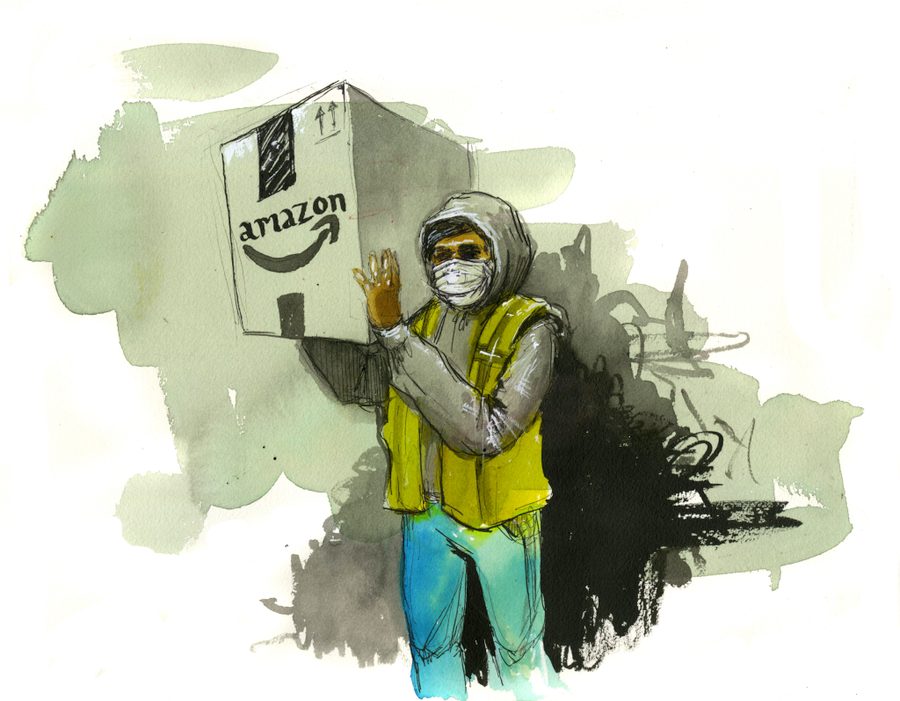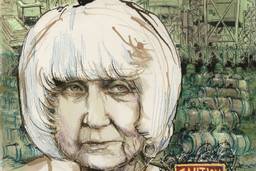The Amazon Delivery Service Worker Who’d Finally Seen Enough
As a driver for an Amazon subcontractor, Frank Chavez encountered unsanitary conditions—including bottles of his coworkers’ urine. Now he’s standing up for his rights.
Michelle Chen and Molly Crabapple

This article is part of a series on Amazon workers produced in partnership with the Economic Hardship Reporting Project.
When aspiring engineer Frank Chavez (a pseudonym) took a job delivering packages for Amazon after graduating from college last December and moving back home with his family in Los Angeles, he thought he’d found a short-term gig to help cover the bills. Then the pandemic exploded in southern California, its accompanying recession clouding his future prospects. Soon Amazon’s booming e-tail empire became his main source of income.
Chavez says his job has gotten tougher over the past few months. While he started out delivering about 230 packages per day, making over 100 stops for a local fulfillment center, those numbers have ballooned during the pandemic to “300, 320, 350 packages, with [as many as] 160 stops. So it was a big spike; [the] number of packages and stops just increased.” In addition, he and his coworkers noticed that rather than delivering to just one address like they had before, “[My employer] started grouping a lot of the houses into one single stack. I find myself going to three different houses for every stop.”
Drivers face intense pressure to finish their deliveries within their shift. “[They] roll their ankles all the time” when rushing from delivery to delivery, he says.
While Amazon’s fulfillment centers are notorious for making workers pack boxes at a breakneck pace, drivers face a different set of risks when covering the so-called “last mile” of the route from the fulfillment center to customers’ doorsteps. Last-mile delivery, a complex and costly component of Amazon’s operations, is often subcontracted to “partners” or third-party delivery services with which the company supplies its branded vans, uniforms and navigation technology. Other couriers are employed through Amazon’s Flex service as independent contractors and drive their own cars. Since Amazon does not officially employ these workers, it avoids direct liability when they run into trouble. Delivery drivers have been involved in about 60 serious vehicle accidents since 2015, according to a 2019 analysis by ProPublica.
The pandemic is “a very scary time for the drivers,” Chavez says, “because we see the majority of workers are staying at home, yet we still keep getting called out to go deliver.” He also notes that his employer, an Amazon contractor, was not providing staff with basic protective equipment for their routes.
When Chavez approached his supervisors to demand masks, gloves, and hand sanitizer, he recalls, “[They] were kind of dismissive. They [said the company] ‘doesn’t have the money to pay for this type of stuff, so this is something that Amazon has to do for you guys.’”
Chavez was intimidated to speak out, initially. “For the most part,” he says, “my coworkers are pretty quiet on this stuff. [We would] talk about it amongst each other and say, ‘Hey, you know, we don’t have any, any masks. That’s messed up. … They should be taking care of us.’ But we won’t say anything out loud because we don’t want to be seen as troublemakers. There’s this idea that if we start to speak up, we could get in trouble.”
Though he had not been at the company long, Chavez soon discovered he wasn’t on his own. A few days after asking about personal protective equipment, he says, his employer started to distribute the gear to workers. He would later learn that Amazon had been pressured by the Warehouse Worker Resource Center (WWRC) — an organization based in Southern California that had circulated petitions on the workers’ behalf and urged Amazon to provide equipment to both its drivers and its fulfillment center employees.
Chavez has since joined his fellow drivers in working with the WWRC to address these kinds of issues, some of which predate the pandemic. As part of the group’s wider campaign to organize workers across Amazon’s operations, the drivers are planning a campaign for overtime hours and schedules that do not overwork them, in addition to clean vans. (Workers currently share their vehicles and have just 15 minutes at the start of each shift to disinfect the cabins.)
Although Amazon would not comment on the specifics of Chavez’s working conditions at an anonymous delivery service, spokesperson Lisa Levandowski said in a statement, “we are doing everything we can to keep [workers] as safe as possible.” The company claims that it has distributed masks to delivery service partners, that “all delivery vehicles and equipment are disinfected each day, and delivery devices and mobile phones are disinfected after each delivery appointment,” and that it has established the Amazon Relief Fund, which supports drivers and other subcontracted workers affected by COVID-19 or financial hardship.
For Chavez, the problems run deeper than disinfected vans. Sanitation as a whole had taken a backseat before the pandemic, he says, with drivers often leaving “pee bottles” behind at the end of a shift. Drivers resort to bottles not only because they are too rushed to take a bathroom break but because their usual pit stops — fast food restaurants — have denied them access to their restrooms due to fears about the coronavirus’ spread. “We have to compromise,” Chavez says, “and sometimes that [means] using a bottle or going in public. … These conditions demoralize us.”
Still, encouraging fellow employees to speak out can be a challenge when work is so precarious. The company, he says, makes workers feel like “we’re replaceable at any minute, especially right now with COVID…[They give the] impression that there’s people that are going to be looking for work, so we kind of have to stay in our lane.” When people have raised concerns about safety and sanitation with the human resources department, he adds, “they tell us that we have the option to resign.”
Chavez claims he and his coworkers were galvanized when they saw that other Amazon workers at a New York fulfillment center had walked off the job. “We were all talking about it,” he recollects. “Like ‘Hey, we should do the same, you know?’” But soon afterward, they were disheartened to learn that one of the workers involved in the protest, Chris Smalls, had been fired—“a big sign that they could basically find a way to get rid of us if we try to organize.”
Still, Chavez has continued meeting with the WWRC alongside some of his co-workers. But it is unclear how long any of the drivers will remain employed since Amazon announced it was cutting contracts with several delivery contractors (including Chavez’s, according to WWRC), triggering some 1200 layoffs. Unlike many of his fellow drivers, he aims to move on to another job soon, and he wants to help those who “feel like their voices are not being heard.”
Amazon has previously stated its opposition to unionization at its fulfillment centers and has been accused of using surveillance and intimidation to suppress organizing among its workforce. Although the WWRC is not a union, Chavez wants the company’s drivers to learn how to advocate for themselves, “so they could have some representation [and have] a clear voice that gets a message across that [reflects] the needs of the workers.”
His inspiration to act, he says, comes from watching his mother work factory jobs his entire life.
“A lot of times she would not speak out on unsafe work conditions…because she was undocumented,” he reflects, “so a lot of factories took advantage of her labor and really didn’t show appreciation. I couldn’t … protect her when I was growing up, so now I feel like I could try to help other people.”
Michelle Chen is a contributing writer at In These Times and The Nation, a contributing editor at Dissent and a co-producer of the “Belabored” podcast. She studies history at the CUNY Graduate Center. She tweets at @meeshellchen.
Molly Crabapple, an artist and writer in New York, is the author of, most recently, Drawing Blood and Brothers of the Gun, (with Marwan Hisham). Her art is in the permanent collections of the Museum of Modern Art. Her animated short, A Message from the Future with Alexandria Ocasio-Cortez, has been nominated for a 2020 Emmy for Outstanding News Analysis: Editorial and Opinion.













